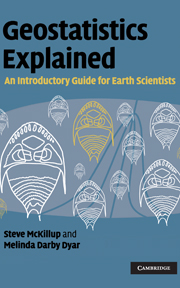Book contents
- Frontmatter
- Contents
- Preface
- 1 Introduction
- 2 “Doing science”: hypotheses, experiments and disproof
- 3 Collecting and displaying data
- 4 Introductory concepts of experimental design
- 5 Doing science responsibly and ethically
- 6 Probability helps you make a decision about your results
- 7 Working from samples: data, populations and statistics
- 8 Normal distributions: tests for comparing the means of one and two samples
- 9 Type 1 and Type 2 error, power and sample size
- 10 Single-factor analysis of variance
- 11 Multiple comparisons after ANOVA
- 12 Two-factor analysis of variance
- 13 Important assumptions of analysis of variance, transformations and a test for equality of variances
- 14 Two-factor analysis of variance without replication, and nested analysis of variance
- 15 Relationships between variables: linear correlation and linear regression
- 16 Linear regression
- 17 Non-parametric statistics
- 18 Non-parametric tests for nominal scale data
- 19 Non-parametric tests for ratio, interval or ordinal scale data
- 20 Introductory concepts of multivariate analysis
- 21 Introductory concepts of sequence analysis
- 22 Introductory concepts of spatial analysis
- 23 Choosing a test
- Appendices
- References
- Index
9 - Type 1 and Type 2 error, power and sample size
Published online by Cambridge University Press: 05 June 2012
- Frontmatter
- Contents
- Preface
- 1 Introduction
- 2 “Doing science”: hypotheses, experiments and disproof
- 3 Collecting and displaying data
- 4 Introductory concepts of experimental design
- 5 Doing science responsibly and ethically
- 6 Probability helps you make a decision about your results
- 7 Working from samples: data, populations and statistics
- 8 Normal distributions: tests for comparing the means of one and two samples
- 9 Type 1 and Type 2 error, power and sample size
- 10 Single-factor analysis of variance
- 11 Multiple comparisons after ANOVA
- 12 Two-factor analysis of variance
- 13 Important assumptions of analysis of variance, transformations and a test for equality of variances
- 14 Two-factor analysis of variance without replication, and nested analysis of variance
- 15 Relationships between variables: linear correlation and linear regression
- 16 Linear regression
- 17 Non-parametric statistics
- 18 Non-parametric tests for nominal scale data
- 19 Non-parametric tests for ratio, interval or ordinal scale data
- 20 Introductory concepts of multivariate analysis
- 21 Introductory concepts of sequence analysis
- 22 Introductory concepts of spatial analysis
- 23 Choosing a test
- Appendices
- References
- Index
Summary
Introduction
Every time you make a decision based on the probability of a particular result, there is a risk that your decision is wrong. There are two sorts of mistakes you can make and these are called Type 1 error and Type 2 error.
Type 1 error
A Type 1 error or false positive occurs when you decide the null hypothesis is false when in reality it is not. Imagine you have taken a sample of size n from a population with known statistics of μ and σ and subjected this sample to a particular experimental treatment. Because the population statistics are known you could test whether this sample mean was significantly different to the population mean by doing a Z test (Section 8.3).
If the treatment had no effect the null hypothesis would apply and your sample would simply be equivalent to one drawn at random from the population. Nevertheless, 5% of the sample means of size n will lie outside the 95% confidence interval of μ ± 1.96 SEM. Therefore, 5% of the time you would incorrectly reject the null hypothesis of no difference between your sample mean and the population mean (Figure 9.1) and accept the alternate hypothesis. This is a Type 1 error.
It is important to realize that Type 1 error can only occur when the null hypothesis applies. There is absolutely no risk if the null hypothesis is false.
- Type
- Chapter
- Information
- Geostatistics ExplainedAn Introductory Guide for Earth Scientists, pp. 105 - 114Publisher: Cambridge University PressPrint publication year: 2010



